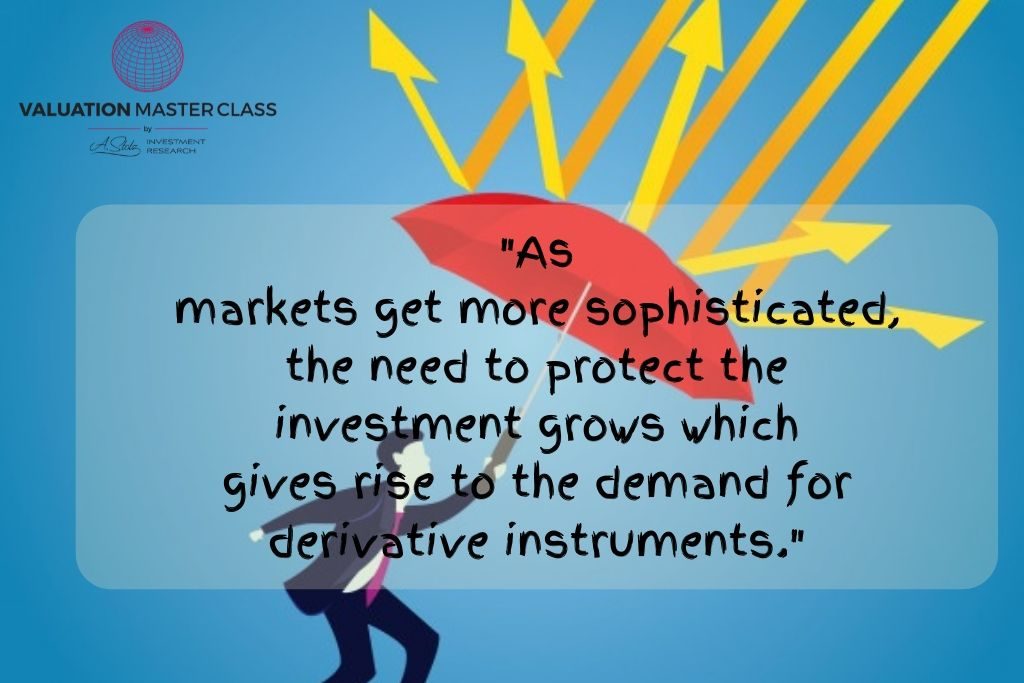Introduction to Derivatives Market

This is a Valuation Master Class student essay by Jiten Dialani from March 6, 2018. Jiten wrote this essay in Module 4 of the Valuation Master Class.
Risk is inherent in financial and commodity markets. All investment instruments in the financial markets face risks in terms of the constant fluctuation in prices, which increase the Investor exposure to such risks. Derivatives were primarily introduced to reduce such risks. They are an arrangement or instrument such as future, options or warrant whose value derive from and are dependent on the value of the underlying asset. Over the past decade, the world has entered into a new phase of increased globalization and liberalization. The integration of capital markets worldwide has given rise to financial risk with frequent changes in the interest rates, currency exchange rates, and stock prices. To reduce the exposure to cross country impact factors, the derivatives need to be procured by Investors to protect their investments from unfavorable fluctuations. Financial derivatives came into the spotlight in the post-1970 period due to growing instability in the financial markets. After their emergence, they became significantly popular and by the1990s, they constituted about two-thirds of the total transactions in derivative products. Derivative contracts can come in various types, the most common ones being forward contracts, future contracts, options contracts, and swaps. Derivatives offer the potential for huge gains and losses. Usually, sophisticated investors use these instruments with a high tolerance for risk. To derive positive returns, an investor must accurately predict the movement of the market, whether it will move up or down. A mistake here in prediction almost guarantees a substantial loss.
Types of Derivatives
There are several types of derivative contracts. The most common ones are forwards, futures, options, and swaps.
Forward Contracts: A forward contract is an agreement between two parties – a buyer and seller – to purchase or sell something in the future at a price agreed upon today and without the right of cancellation. Key features of forward contracts include:
- Customization wherein the parties can determine the terms, features, date of delivery and exact identity of the underlying asset;
- Counterparty default risk covers the risk that the other party may not make the required delivery or payment;
- Unregulated markets involving large transactions among banks, investment banks, government, and corporations;
- Underlying assets involving stocks, bonds, foreign currencies, commodities, interest rates;
- Forward contracts tend to be held until maturity with little or no market liquidity.
Future Contracts: A future contract is also an agreement between a buyer and seller to transact something at a future date at the price on the date of purchase. Key features of a futures contract include:
- Standardized terms and conditions;
- Trading takes place in a formal exchange which provides the parties the place and mechanism to trade the contracts;
- There is no default risk because the exchange acts as a counterparty, guaranteeing delivery and payment by use of a clearinghouse;
- Clearinghouse protects itself from default by requiring its counterparties to settle gains and losses or mark to market their positions daily;
- Futures have deep liquidity, are standardized and traded on an exchange;
- An investor can offset his or her position by engaging in an opposite transaction before the stated maturity of the contract.
Options: An option is a contract or provision of a contract giving the option holder the right, but not the obligation to perform a specified transaction. The transaction is with the option issuer or option writer according to the terms specified in the contract. Options trade on Exchanges or Over the Counter (OTC). Most exchange-traded options have stocks as their underlying asset, but OTC traded options include bonds, currencies, commodities, swaps or baskets of assets. There are two main types of Options: Calls and Puts.
Call options give the holder the right, but not the obligation to purchase an underlying asset at a strike price. If the asset fails to meet the strike price before expiry, then the option expires and becomes worthless. Investors buy call options when they think that the price of the underlying asset would rise.
Put options give the holder the right to sell an underlying asset at the strike price to the option issuer during the contract period. The option issuer is obligated to buy the option at the strike price. Put Options are purchased when an investor feels that the underlying asset’s price will fall in the future. Put buyers could also be insurance companies who are looking to protect their long positions in a stock covered by an option.
Swaps: A swap is a cash-settled contract between two parties to exchange or swap cash-flow streams usually traded OTC. As long as the present value of the cash-flow streams is equal, swaps can entail any future type of cash-flow. They are most often used to change the character of the asset or liability without having to liquidate that liability, for instance, an equity stockholder could swap his returns with that of lower-income fixed cash flows without having to liquidate his equity position. The difference between swaps and forwards is that a swap will involve a series of payments in the future, whereas forwards involve only one single future payment. The two most basic types of swaps are interest rate swap and currency swap. Interest swaps are usually when a borrower having a fixed interest loan wants to exchange his loan with that of floating interest or vice versa. The currency swap is similar to interest swap except that the cash flows are in different currencies. Currency swaps can be used to exploit inefficiencies in international debt markets.
Advantages of Derivatives
As markets get more sophisticated, the need to protect the investment grows which gives rise to the demand for derivative instruments. The main advantages of buying derivatives are as below:
Price Discovery: Future market prices depend upon a continuous flow of information, political and economic conditions that are dynamic and keep affecting the market movements. This kind of information and the way people absorb it constantly changes the price of an asset, this process is called Price Discovery. Options also aid in price discovery when we see the demand for a particular option in a given market going up or down, this gives the investor an indication of the expected market movement.
Risk Management: This is an important purpose of the derivatives market whereby the actual level of risk is altered to meet the desired level of risk. This process can fall into the categories of hedging and speculation. The hedging strategy is used to minimize the risk in holding a particular market position while speculation is referred to as taking a position in the way markets will move. Today hedging and speculation are useful tools for a Company to effectively manage its risk.
Limitations of Derivatives
Options offer the potential for huge gains as well as losses. While the potential for gain could be alluring, their complexity makes them appropriate only for sophisticated investors with a high tolerance for risk. The main limitations or risks of derivatives are as below:
Lifespan: Derivatives are time-wasting assets. As each day passes, the expiry date approaches, a person loses more and more of the time premium and the option’s value decreases if the strike price is not met.
Direction and Market Timing: To reap the benefits of derivatives, an investor must accurately predict the market movement otherwise there would be a substantial loss of investment if the market does not move as predicted.
Conclusion
Derivatives have changed how investors and money managers invest and have given an option to safeguard their investments. Despite the complexities of derivative instruments and the difficulties involved for the casual investor to comprehend them, their benefits are also important to consider. Derivatives have given companies the option to manage their risk exposure. These instruments also indicate the expected market movement by observing the trends in higher or lower demand of a particular derivative.
References
- Shodhganga website Article: Introduction to Derivatives Instrument
- Investopedia website Article: Derivatives
- Srishti (2012) “Types of Derivatives and Derivatives Market,” Blog-ipleaders.in

